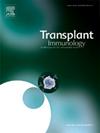口服环孢素纳米混悬液改善免疫抑制效果:大鼠体内细胞因子谱。
IF 1.4
4区 医学
Q4 IMMUNOLOGY
引用次数: 0
摘要
背景:环孢素A (Cyclosporine A, CycA)是移植中的基础免疫抑制剂,但其溶解度差和生物利用度多变限制了其治疗效果。纳米悬浮液技术提供了一种创新的配方策略,以增强口服吸收,并有可能改善免疫调节作用。方法:Wistar大鼠(n = 4只/组)口服CycA粗粉、物理混合物、商品产品和纳米混悬液。血清细胞因子和趋化因子(IL-4、IL-5、IL-10、IL-13、IL-17 A、Eotaxin、GRO-α、IP-10、MCP-1、MCP-3、MIP-1α、MIP-2、Rantes)在第7、14和21天进行定量。数据以平均值 ± SD表示。统计学分析采用Mann-Whitney U检验,多组比较采用Benjamini-Hochberg校正。结果:在第21天,与对照组和粗粉相比,纳米悬液组IL-10水平显著升高(调整p = 0.041),证实纳米悬液介导IL-10上调。与对照组相比,纳米混悬液和商业产品组IL-13也升高(p_adj = 0.048)。纳米悬浮液组IL-4在第7天(p_adj = 0.042)和第21天(p_adj = 0.049)均显著降低。与对照组和粗粉相比,纳米混悬液组IL-5水平在第21天升高(p_adj = 0.037)。IL-17 A或趋化因子未检测到统计学上的显著差异,尽管描述性趋势表明纳米悬浮液组的特征发生了改变。结论:CycA纳米悬浮液通过上调IL-10、微调Th2细胞因子(IL-4、IL-5、IL-13)、趋化因子调控等方式选择性调节细胞因子网络。这些发现突出了纳米悬液技术作为一种有前途的策略来增强CycA的免疫抑制效果,对移植有潜在的影响。本文章由计算机程序翻译,如有差异,请以英文原文为准。
Oral cyclosporine a nanosuspension for improved immunosuppressive efficacy: In vivo cytokine profiling in rats
Background
Cyclosporine A (CycA) is a cornerstone immunosuppressant in transplantation, but its poor solubility and variable bioavailability limit therapeutic efficacy. Nanosuspension technology offers an innovative formulation strategy to enhance oral absorption and potentially improve immunomodulatory effects.
Methods
Wistar rats (n = 4/group) received oral CycA as coarse powder, physical mixture, commercial product, or nanosuspension. Serum cytokines and chemokines (IL-4, IL-5, IL-10, IL-13, IL-17 A, Eotaxin, GRO-α, IP-10, MCP-1, MCP-3, MIP-1α, MIP-2, Rantes) were quantified on days 7, 14, and 21. Data were expressed as mean ± SD. Statistical analysis was performed using Mann–Whitney U test with Benjamini–Hochberg correction for multiple comparisons.
Results
At day 21, IL-10 levels were significantly higher in the nanosuspension group compared to control and coarse powder (adjusted p = 0.041), confirming nanosuspension-mediated IL-10 upregulation. IL-13 was also elevated in nanosuspension and commercial product groups versus control (p_adj = 0.048). IL-4 was significantly reduced in the nanosuspension group at both day 7 (p_adj = 0.042) and day 21 (p_adj = 0.049). IL-5 levels increased in the nanosuspension group at day 21 compared to control and coarse powder (p_adj = 0.037). No statistically significant differences were detected for IL-17 A or chemokines, although descriptive trends suggested altered profiles in the nanosuspension group.
Conclusion
CycA nanosuspension selectively modulates cytokine networks by elevating IL-10, fine-tuning Th2 cytokines (IL-4, IL-5, IL-13), and trending toward chemokine regulation. These findings highlight nanosuspension technology as a promising strategy to enhance CycA's immunosuppressive efficacy, with potential implications for transplantation.
求助全文
通过发布文献求助,成功后即可免费获取论文全文。
去求助
来源期刊

Transplant immunology
医学-免疫学
CiteScore
2.10
自引率
13.30%
发文量
198
审稿时长
48 days
期刊介绍:
Transplant Immunology will publish up-to-date information on all aspects of the broad field it encompasses. The journal will be directed at (basic) scientists, tissue typers, transplant physicians and surgeons, and research and data on all immunological aspects of organ-, tissue- and (haematopoietic) stem cell transplantation are of potential interest to the readers of Transplant Immunology. Original papers, Review articles and Hypotheses will be considered for publication and submitted manuscripts will be rapidly peer-reviewed and published. They will be judged on the basis of scientific merit, originality, timeliness and quality.
 求助内容:
求助内容: 应助结果提醒方式:
应助结果提醒方式:


